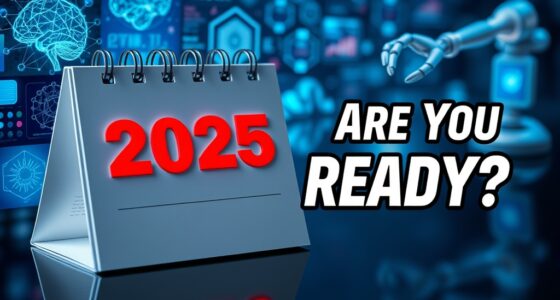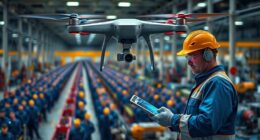Algorithms now manage many workplace tasks, from assigning work to monitoring performance. They aim to boost productivity but can increase stress, reduce trust, and cause feelings of isolation if not implemented transparently. While AI tools support decision-making and HR functions, workers often worry about fairness, privacy, and job security. Understanding how these systems work and their impact on you can help you navigate this evolving environment—if you’re curious, there’s more to explore.
Key Takeaways
- Algorithms now handle tasks like assigning, monitoring, and evaluating work, reducing human supervision in many workplaces.
- Automated management tools aim to optimize productivity but can cause stress, mistrust, and emotional disconnect among employees.
- Transparency, ethical use, and worker empowerment are essential to build trust in algorithmic management systems.
- AI-driven decision-making enhances real-time insights, workforce planning, and personalized HR strategies.
- Balancing automation benefits with human oversight is crucial to maintain morale, well-being, and ethical standards at work.
The Rise of Algorithmic Management in the Workplace
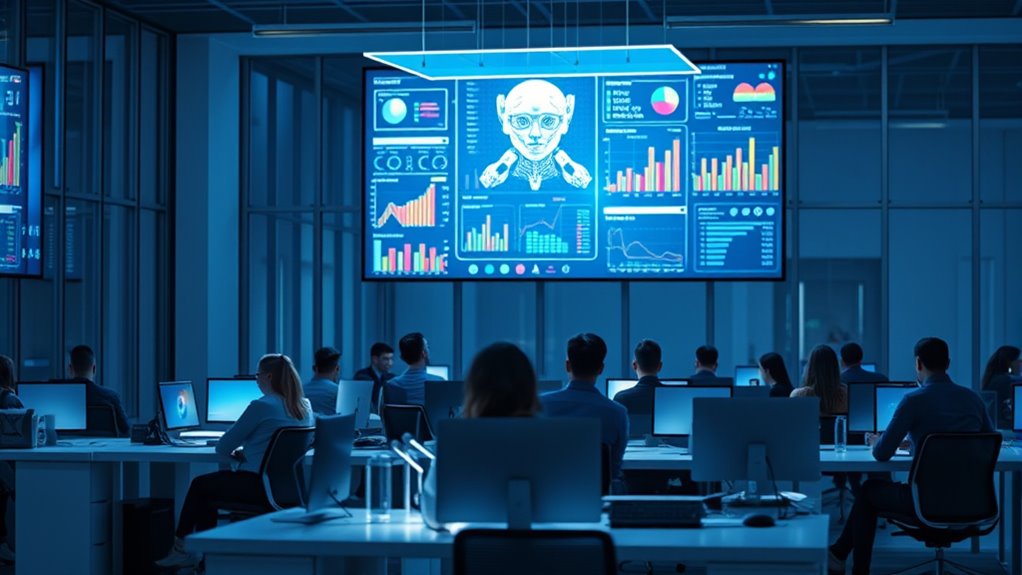
The rise of algorithmic management in the workplace reflects a significant shift towards using software and AI to handle tasks traditionally managed by humans. These systems organize, assign, monitor, supervise, and evaluate work based on tracked data, aiming to optimize workflows and boost productivity. Widely adopted across countries like the U.S., Germany, Japan, and others, over 6,000 firms now use these tools, highlighting their popularity. While they can make decisions more consistent and objective, concerns about trustworthiness and accountability remain. These systems increase worker surveillance, which can cause stress and impact well-being. Despite their efficiency benefits, many worry about transparency and the potential negative effects on employee health. For example, some companies incorporate essential oils to help reduce employee stress and improve overall well-being in high-pressure environments. As adoption grows, balancing these advantages with worker protections becomes increasingly critical, especially considering the regulations that govern workplace monitoring and employee rights.
How AI Enhances Decision-Making and Efficiency

AI considerably boosts decision-making and efficiency in the workplace by processing vast amounts of data in real time to generate actionable insights. It helps you make better choices by analyzing large datasets quickly, surfacing key trends, and providing data-driven recommendations. While AI streamlines operations and automates tasks—potentially handling up to 25% of work—it also offers real-time insights that allow quick adjustments. Here’s a snapshot:
| AI Capabilities | Benefits |
|---|---|
| Data Analysis | Identifies trends, forecasts outcomes |
| Task Automation | Automates repetitive work, boosts productivity |
| Predictive Modeling | Forecasts future trends, informs strategy |
| Real-Time Insights | Enables quick operational adjustments |
Though AI enhances decision-making, human judgment remains essential for contextual understanding. AI’s ability to analyze data across multiple modalities further amplifies its effectiveness in complex scenarios. Recognizing the importance of patterns in angel numbers can also guide strategic decisions and interpersonal insights in the workplace. Additionally, understanding how to identify bad lemon juice can help in maintaining quality standards and avoiding spoilage in related tasks. Incorporating data interpretation skills is vital for maximizing AI’s potential and ensuring ethical use of technology. Moreover, developing a comprehensive content strategy aligned with AI insights can significantly improve overall organizational performance.
Worker Experiences and Concerns With Automated Supervision
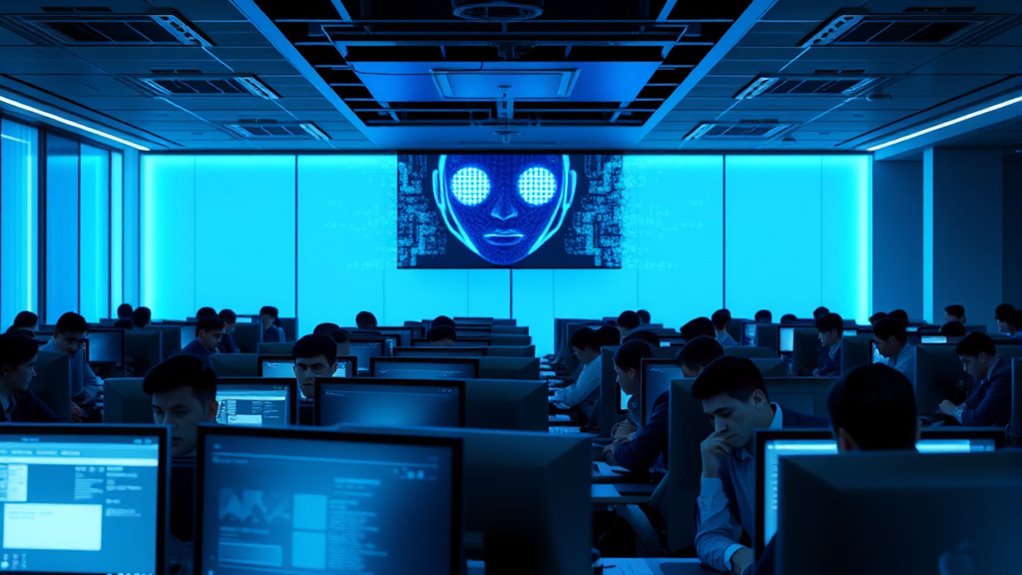
When automated supervision replaces human interaction, you may feel increased stress and a sense of isolation. Trust issues can arise when you see systems as punitive rather than supportive, affecting your confidence in management. Without clear accountability, you might worry about fairness and your ability to voice concerns effectively. Over two-thirds of U.S. workers experience some form of automated monitoring, which can intensify these feelings and perceptions. Incorporating paint sprayer techniques into workplace automation could influence perceptions of control and fairness in supervision. Additionally, understanding how space and organization strategies can reduce clutter and improve mental clarity might help mitigate some stressors associated with automated environments. Recognizing the importance of dog breeds and their unique traits can foster empathy and patience in team dynamics, easing tensions in high-pressure settings. Being aware of credit card insights related to personal finance management can also help employees feel more empowered and less vulnerable to the pressures of digitized supervision.
Stress From Lack of Human Interaction
Lack of human interaction in automated supervision can considerably heighten your stress levels and feelings of isolation. Without a supervisor to connect with, you might feel neglected and unsupported, which can drain your motivation. Automated systems lack empathy, so communication often feels impersonal, making workplace issues harder to resolve. This emotional gap can lead to lower job satisfaction and increased anxiety. The absence of personal feedback leaves you uncertain about your performance, fueling stress. Repetitive tasks and constant monitoring add to the pressure, making it difficult to find a sense of normalcy. Over time, this disconnect can affect your mental health, causing feelings of loneliness and burnout. Without human interaction, managing work stress becomes more challenging, impacting both your well-being and productivity. Additionally, resources and tools such as support systems or counseling can help mitigate some of these negative effects. A better understanding of Self Watering Plant Pots can serve as a reminder that systems designed with proper support and balance promote healthier growth—whether for plants or employees. Recognizing the importance of attention and other emotional cues can help you better interpret your environment and reduce misunderstandings in automated settings. Automation’s growing role in the workplace can further intensify these feelings if not balanced with supportive human engagement. Understanding how color accuracy and visual cues influence perceptions can also aid in reducing miscommunications and improving overall workplace harmony. Understanding how Paint Sprayer Reviews & Buying Guides influence perceptions of quality might also provide comfort in assessing your work environment.
Trust and Accountability Issues
Automated supervision reshapes workplace trust by creating significant gaps between workers and management. You might feel that surveillance erodes your sense of trust, as many workers perceive a lack of confidence from employers. Trust depends on mutual confidence: you need to trust management, and they must trust you. Factors like system capabilities, environment, and personal differences influence how much you trust automation. When organizations transparently share information and empower workers, trust can grow. However, over-monitoring often leads to feelings of mistrust, unapproved breaks, and decreased well-being. Workers worry about ethical issues, discrimination, and limited access to collective action. Implementing ethical guidelines and ensuring fairness in algorithmic decisions are crucial steps toward maintaining trust. For example, incorporating sound design principles such as clarity and transparency into algorithm communication can help improve understanding and acceptance. Finding the right balance through transparency, fairness, and autonomy is essential to rebuild trust and ensure accountability in automated workplaces. Recognizing the importance of worker perceptions can also help organizations address concerns effectively and foster a healthier work environment. Incorporating smart marketing strategies can also help organizations communicate their intentions clearly and foster a culture of trust and engagement. Additionally, understanding workplace dynamics is essential for creating systems that support both efficiency and employee well-being.
The Impact of Algorithms on Job Satisfaction and Stress Levels

Algorithms can boost job satisfaction for managers by reducing routine tasks, but workers often feel more stressed under increased monitoring. Automation may lessen stress for some but can also elevate pressure and workload for others. Understanding how algorithmic monitoring impacts both satisfaction and stress is essential for creating balanced workplaces. Additionally, the use of vetted systems ensures that these tools are safe and effective in managing human tasks. Recognizing algorithmic transparency can help mitigate feelings of distrust and uncertainty among employees, especially as ethical considerations become more prominent in deploying these technologies. Incorporating home decor principles such as wall organization and clutter reduction can also help create more comfortable and stress-relieving work environments at home. Moreover, the implementation of Pimple Patch technology in wellness programs illustrates how targeted solutions can improve individual well-being amidst digital management systems.
Algorithmic Monitoring Effects
The widespread use of monitoring technologies in the workplace has a profound effect on job satisfaction and stress levels. When algorithms constantly track your performance, it can lead to burnout and feelings of threat, reducing your sense of control and engagement. This persistent surveillance creates a tense environment, elevating anxiety and mental fatigue. You might notice:
- Reduced autonomy and job satisfaction
- Increased feelings of unfairness and unpredictability
- Heightened stress and anxiety
- Resistance behaviors like gaming the system
- Erosion of trust and morale
These effects are amplified when monitoring lacks transparency, leaving you unsure about how decisions are made. Over time, this can foster resentment and diminish your overall well-being, highlighting the need for balanced, human-centered approaches to algorithmic oversight. Recognizing the importance of trust and understanding in the workplace can help mitigate some of these negative impacts.
Stress From Automation
Have you ever wondered how automation impacts your job satisfaction and stress levels? Most employees find automation boosts their satisfaction—89% feel happier at work, and 84% are more satisfied with their company. Automation reduces repetitive tasks, helping you avoid boredom and feel more confident in your skills. It can also improve workplace dynamics, making your environment more engaging. However, stress remains a concern: half of North American workers experience daily stress, and over 70% of Gen Z employees struggle with workplace well-being, often worsened by automation worries. Concerns about AI errors, cybersecurity, and job displacement—especially for those in highly automated roles—add to stress. Still, automation can also reduce stress by managing workload and increasing productivity, ultimately shaping a more satisfying work environment.
AI’s Role in Workforce Planning and Skills Forecasting

How is artificial intelligence transforming workforce planning and skills forecasting? AI is revolutionizing how you plan and prepare for future talent needs. It enables real-time analytics to allocate resources efficiently and helps create holistic talent strategies by analyzing workforce trends. AI-driven skills assessments and predictive analytics forecast which skills will be in demand, guiding retraining initiatives for millions of workers. It also identifies current skills gaps, ensuring your organization stays competitive.
AI revolutionizes workforce planning by enabling real-time analytics, predicting skill demand, and identifying gaps to keep organizations competitive.
- AI helps in predicting future talent demand
- It streamlines internal talent development
- Real-time data improves decision-making
- Skills gap analysis highlights training priorities
- AI supports strategic workforce adjustments
Transforming HR Functions: Performance, Compensation, and Benefits
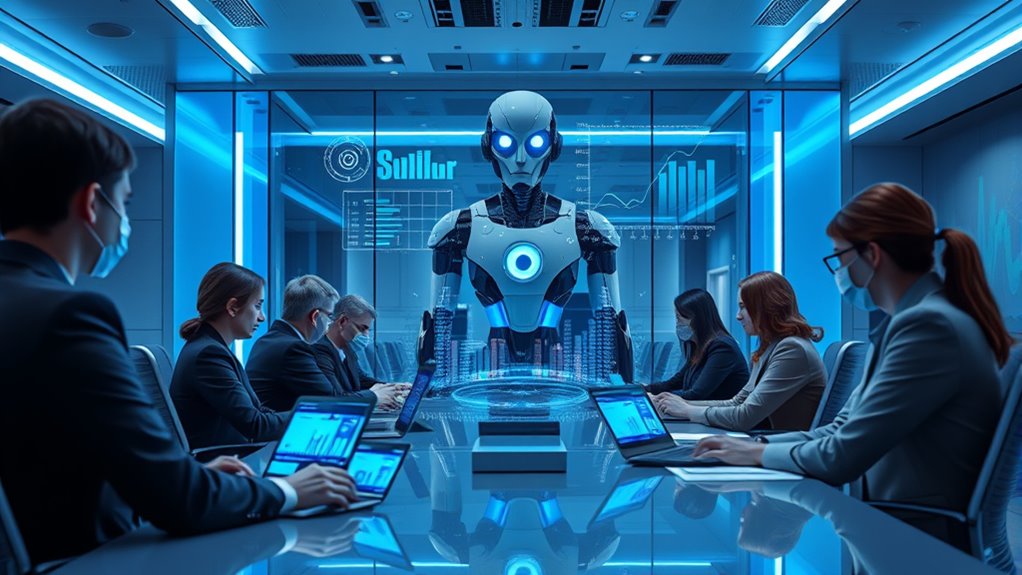
Artificial intelligence is revolutionizing HR functions by automating routine tasks and providing data-driven insights, allowing you to make more informed decisions across performance, compensation, and benefits. In performance management, AI reduces bias, streamlines reviews, and predicts employee development needs. It can generate personalized feedback, helping employees improve effectively. When it comes to compensation, AI analyzes market trends and internal equity, automates calculations, and promotes fairness. It also enhances transparency by explaining decisions clearly. For benefits, AI personalizes offerings based on employee preferences, automates enrollment, and analyzes usage patterns to optimize costs. Overall, AI makes HR processes more efficient, equitable, and employee-centric, empowering you to focus on strategic initiatives while delivering better outcomes for your workforce.
The Growing Market and Workforce for AI in Business
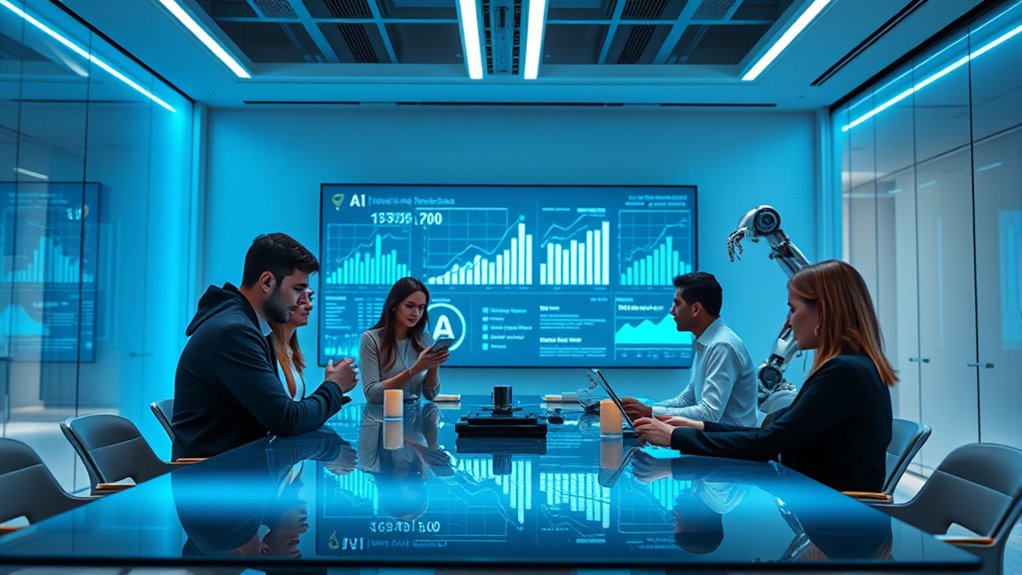
The AI job market is experiencing rapid expansion, with over 35,000 AI-related openings in the U.S. during the first quarter of 2025—an increase of 25.2% compared to the previous year. This surge reflects the growing demand for specialized AI roles such as Data Scientists, AI/Machine Learning Engineers, and Big Data Engineers. Significantly, AI/Machine Learning Engineer positions grew 41.8% year-over-year, highlighting their strategic importance. As AI adoption accelerates, organizations are heavily investing, with 78% using AI in 2024 and 92% planning increased spending.
- Demand for AI talent is expanding across industries and regions
- Salaries for AI roles are rising, with a median of $156,998
- Traditional sectors see less growth, shifting toward automation
- Companies seek diverse, high-skilled AI professionals
- Workforce transformation is reshaping labor markets
Future Trends: Automation, Trust, and Policy Needs

Automation is reshaping workplace operations by boosting efficiency and helping organizations adapt to labor shortages and shifting market demands. With 76% of employees expecting AI to profoundly impact work by 2025, you’ll see digitization improving productivity across sectors. AI builds the infrastructure for organizations to fine-tune workforce capabilities, fostering seamless collaboration between humans and digital systems instead of replacing workers. Trust becomes essential as AI manages performance and decisions; transparency and ethical policies help build confidence. Regulatory frameworks are emerging to address privacy, bias, and fairness, balancing innovation with employee rights. To stay ahead, you’ll need to develop digital literacy and collaborate effectively with AI tools. Overall, future trends focus on integrating automation thoughtfully, emphasizing trust and robust policies to ensure responsible, efficient workforce evolution.
Navigating the Human-AI Management Landscape

As AI becomes a central part of daily management practices, organizations are finding new ways to blend human judgment with algorithmic insights. To navigate this landscape effectively, you need to understand how AI complements human roles and addresses concerns. Success hinges on balancing automation benefits with employee well-being. Keep in mind:
- AI enhances productivity but may cause fears of pay cuts among managers.
- Collaboration between humans and AI is viewed as more beneficial than replacement.
- Ethical use and data privacy remain essential in HR and decision-making.
- Continuous skill development is necessary to adapt to changing roles.
- Maintaining empathy and human interaction is indispensable for a healthy workplace environment.
Frequently Asked Questions
How Do Employees Feel About Reporting to AI Managers?
You might feel uncertain or skeptical about reporting to AI managers, especially if you’re worried about transparency or trust. Some employees are excited about the efficiency, while others fear job security or feel disconnected from decision-making. Your reaction depends on how well the organization supports you with training, clear communication, and opportunities to provide feedback. Building trust and understanding is essential for you to feel comfortable working under AI management.
What Legal Rights Do Workers Have Under Algorithmic Management?
You’ve heard the saying, “knowledge is power,” and that’s true for workers under algorithmic management. Currently, your legal rights are limited; existing laws often don’t fully protect you from unfair surveillance or decision-making. You may have rights around data privacy and fair treatment, but these are often insufficient. Advocates push for reforms to give you more control, accountability, and a voice in how algorithms influence your work.
How Is Bias Prevented in Ai-Driven Decision Systems?
You prevent bias in AI-driven decision systems by conducting regular audits to identify unfair patterns, ensuring your data is diverse and high-quality, and applying fairness metrics to assess outcomes. You also implement debiasing techniques and use bias detection tools, all while maintaining transparency. Training your team on ethical AI practices and establishing strong governance policies helps you build equitable systems that minimize discrimination and promote fairness.
What Training Is Needed for Workers to Interact With AI Management Tools?
You need to get your ducks in a row when it comes to AI management tools. This means training yourself on how these tools work, including their applications and limitations. Focus on understanding data analysis, automation, and troubleshooting. Learning about ethical considerations and compliance guarantees responsible use. With proper training, you’ll be better equipped to collaborate effectively with AI, making your work more efficient and aligned with organizational goals.
How Do Companies Address Accountability When AI Makes Errors?
When AI makes errors, companies take responsibility by establishing clear guidelines for accountability, including human oversight and audit trails. They implement continuous monitoring, regular audits, and incident reporting to spot and fix mistakes quickly. Transparency is key; organizations communicate AI limitations and error rates openly. They also align error management with legal and ethical standards, involving review boards and stakeholder dialogue to ensure responsible AI use and accountability.
Conclusion
As you navigate this evolving landscape, remember that “trust, but verify.” Algorithms can boost efficiency, but they shouldn’t replace the human touch. Embrace AI’s potential to enhance your work, yet stay vigilant about its limitations and impacts on well-being. By balancing technology with empathy, you’ll shape a future where humans and bots work together harmoniously, ensuring progress without losing sight of what truly makes work meaningful.




